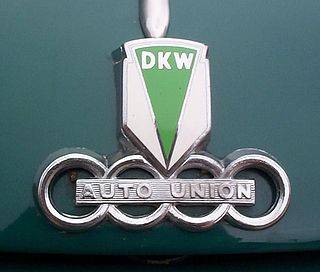
DKW was a German car and motorcycle marque. DKW was one of the four companies that formed Auto Union in 1932 and is hence an ancestor of the modern day Audi company.

The Ford Eifel is a car manufactured by Ford Germany between 1935 and 1940. It initially complemented, and then replaced, the Ford Köln. It was itself replaced by the Ford Taunus.

F103 is the internal designation for a series of car models produced by Auto Union GmbH in West Germany from 1965 to 1972, derived from the earlier DKW F102. To signify the change from a two-stroke to four-stroke engine, the DKW marque was dropped in favour of Audi, a name that had been dormant since before the Second World War.

The DKW F8 compact front-wheel drive two-stroke engined saloon was introduced in 1939. The F8 was slightly shorter than its predecessor despite having a marginally increased wheelbase. The base model, known as the Reichsklasse, was manufactured only till 1940 but the Meisterklasse sedan continued in production until 1942. In addition to the saloons, cabriolet versions were offered.

Initially presented early in 1933, the Audi Front UW 220 was Europe’s first car to combine front-wheel drive with a six-cylinder engine. It remained in production for slightly under two years before being replaced by the Audi Front UW 225 featuring a larger 2.25-litre engine. The larger-engined car introduced in 1935 was built till April 1938 and continued to be listed into 1939. Between 1933 and 1938, the Front was the only Audi in volume production.

The Audi Type C was introduced in 1912. It became popular with the German people and Army, being brought back into production for a couple of years after the war. Its performance, handling and reliability along with rally successes greatly raised Audi's profile, and the Type C was a commercial success. 1,116 cars were produced.
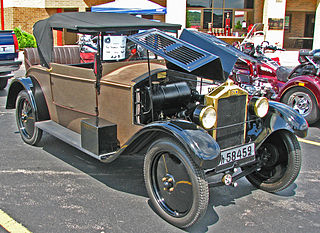
The DKW Typ P was the first motor car made by DKW. It was a light-weight design with a unit body made of wood and imitation leather. It was powered by a two stroke inline twin engine.

The Audi Type B was introduced in 1910 as a successor to the Audi Type A, there was an overall 360 of the Type B built. It used a four-cylinder, two-block inline engine with 2.6 Litres of displacement. It developed 28 PS through a four-speed countershaft gearbox and a propeller shaft, which drove the rear wheels. The car had a ladder frame and two leaf-sprung solid axles.
The Audi Type D was introduced in 1911. The vehicle had a four-cylinder in-line engine with 4.7 litres of displacement. It developed 45 PS over a four-speed countershaft gearbox and a propeller shaft, which drove the rear wheels. The car had a ladder frame and two leaf-sprung solid axles. The Type D was available as a four-seat touring car or four-door sedan. Until 1920, only 53 copies of the car were built.
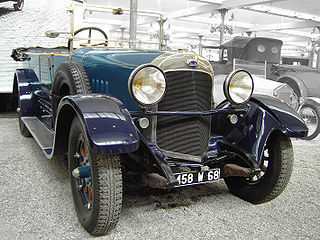
The Audi Type E was a passenger car introduced by Audi in 1913. It was the largest pre-war car from Audi.
The Audi Type K was a car introduced by Audi at the Berlin Motor Show in September 1921. Since the end of the war Audi had till now produced only cars of pre-war design, so that the Type K was the first post-war Audi design to be offered. The Type K entered production in 1922 and was withdrawn in 1925, by which time the company had commenced production, in 1924, their Type M model which can be seen as a larger replacement for the Type K. The Audi Type K was the first volume produced car in Germany to feature left-hand drive.
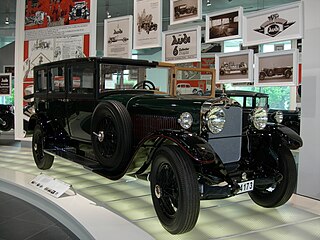
The Audi Type M was a large car first presented at the Berlin Motor Show in 1923 and produced by Audi between 1924 and 1927.

The Audi Type P was a small two-door sedan/saloon car introduced by Audi in 1931. It was discontinued by 1932.

The Audi Type R was a large car produced by Audi between 1928 and 1932 as a successor to the Audi Type M.

The Audi Type SS was a large, eight-cylinder-powered sedan/saloon car introduced by Audi in 1929 in succession to the Type R "Imperator".
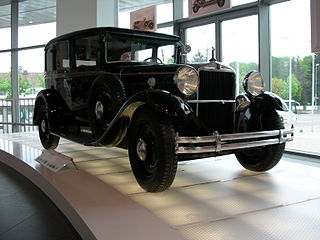
The Audi Type T was a large, 6-cylinder-powered sedan/saloon car introduced by Audi in 1931. It was in most respects a scaled-down version of the manufacturer's Type SS "Zwickau", which had appeared two years earlier.
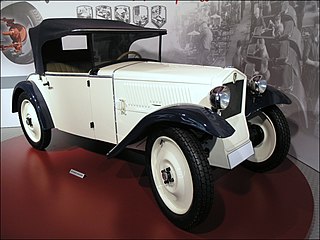
The DKW F1 was a small car produced by DKW between 1931 and 1932. It was launched at the Berlin Motor Show in February 1931.

The Goliath Pionier is a small three-wheeled two-seater vehicle first presented by Carl F. W. Borgward at the 1931 Berlin motor show. It remained in production until 1934, by when approximately 4,000 had been produced.

The Mercedes-Benz W 153 was a luxury six cylinder passenger car built in parallel with the W 143 from 1938, and first presented in public at the Berlin Motor Show early in 1939. It was one of several Mercedes-Benz models known, in its own time, as the Mercedes-Benz 230.

The Benz 10/25 PS was a midsize automobile introduced by Benz & Cie in 1912. The same year stated maximum output was increased which meant a name change to Benz 10/30 PS. The model disappeared for three years following the First World War but returned in 1921. A further power increase in 1926 meant another name change, now to Benz 10/35 PS. Following the "fusion" between the Daimler and Benz companies, production of the Benz 10/35 PS ended in 1927.